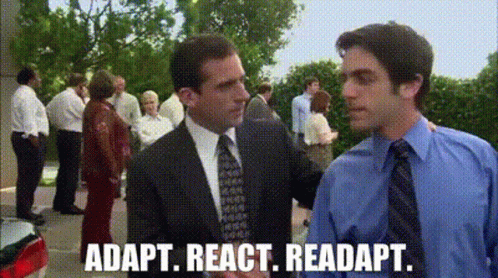Thriving in Ambiguous Software Workplaces: Turning Uncertainty into Opportunity
Learn how to embrace ambiguity as a software engineer, by adapting channeling your creative problem solving skills.

Ambiguity at work is the stuff that can make even the most seasoned devs break into a cold sweat.
Software workplaces are inherently ambiguous, filled with shifting priorities, vague project requirements, and technologies that seem to change every other Tuesday.
The thing is, ambiguity doesn’t have to be your enemy.
With the right mindset, skills, and strategies, you can not only survive but thrive in uncertain environments.
Let’s explore how you can make ambiguity work for you, not against you.
🔑 Key Takeaways 🔑
- Adaptability is key: Treat ambiguity as mental yoga—stretch your ability to adjust and grow from it.
- Problem-solving skills matter: Break down challenges, brainstorm freely, and innovate your way through the fog.
- Resilience keeps you balanced: Know your strengths and build supportive networks to keep moving forward.
- Psychological safety is crucial: Foster a culture where team members can share ideas without fear.
- Embrace ambiguity: Shift your mindset to see ambiguity as a growth opportunity, not an obstacle.
Skills You Need to Thrive in Ambiguity
To thrive in an ambiguous workplace, adaptability is your number one asset.
Think of it as mental yoga—stretching your ability to adjust to whatever comes your way.
Whether it's taking on tasks outside your usual scope or pivoting when the goals of your project get redefined, adaptability makes it all possible.
Want to boost this skill?
Start by exposing yourself to new experiences, both in and out of work.
Try picking up a new hobby or changing your routine—it'll make you more comfortable with the discomfort of change.
Ambiguity loves to bring complex challenges, and this is where Problem-solving shines.
The first step? Understand the root of the challenge before diving in.
Use tools like mind mapping to organize information visually—it can reveal connections you might otherwise miss.
After you’ve figured out the problem, don’t be afraid to brainstorm freely.
Get your team involved, let the ideas flow, and don’t judge them too soon.
Remember, in the fog of ambiguity, creativity often holds the key.
Resilience is what keeps you balanced when things get murky.
It’s about maintaining your purpose even when the path ahead is unclear.
Start with self-awareness: know your strengths and your limitations.
Build a supportive network too—find mentors, connect with peers, and engage with those who have faced similar challenges for resilience.
These relationships can provide valuable perspectives and help you keep your sanity intact when things get rough.
Managing Ambiguity as a Team
Ambiguity is a breeding ground for anxiety, but it doesn’t have to be.
Creating a culture of psychological safety means everyone on the team feels comfortable expressing their thoughts without fear of judgment or backlash.
When your team knows they can share concerns and questions openly, collaboration thrives.
Leaders need to model this—share your own uncertainties, ask for input, and make it clear that mistakes are part of the process.
You need to communicate, Even When It’s Uncomfortable.
Effective communication in an ambiguous environment is like being a captain navigating foggy waters—you need a clear compass.
Open dialogue and active listening are key.
Make sure everyone knows what’s known, what’s still a mystery, and what could potentially change.
Be upfront about uncertainties rather than pretending they don’t exist.
When people feel informed, even if the information is incomplete, they’re more likely to stay engaged and productive.
Ambiguity often blurs individual roles and responsibilities, making team collaboration more important than ever.
Utilize structured frameworks like Agile to keep projects organized even when requirements are in flux.
These iterative approaches, with their focus on regular feedback and adaptability, are perfect for ambiguous environments.
And remember—collaboration is about combining diverse perspectives, so foster a culture of open dialogue and shared responsibility.

Mindset Shifts to Embrace Ambiguity
Ambiguity is not going anywhere, so it’s time to make peace with it.
Instead of fighting the unknown, see it as an opportunity to grow.
Ambiguity can push you to innovate, think outside the box, and learn new skills.
Approach each vague project or changing requirement with curiosity.
Ask yourself, “What can I learn here?” rather than, “Why is this happening to me?”
This shift can turn stress into excitement.
Sometimes, ambiguity stems from a lack of leadership—a project with no clear direction or goals that shift weekly.
In these moments, self-leadership becomes crucial.
Define what success looks like for you, even if it’s not entirely clear from the top.
Set your own goals and communicate them to your manager.
By taking charge of your role, you reduce the paralysis that often comes with waiting for others to decide your path.
Conclusion
Ambiguity is like the wild west of software workplaces—full of unknowns, but also full of opportunities.
Whether you’re dealing with shifting project goals, undefined responsibilities, or the general chaos of an ever-evolving tech landscape, the key is to embrace the mess.
By developing adaptability, sharpening your problem-solving skills, fostering open communication, and leading yourself when no one else does, you’ll not only survive ambiguity—you’ll thrive in it.




